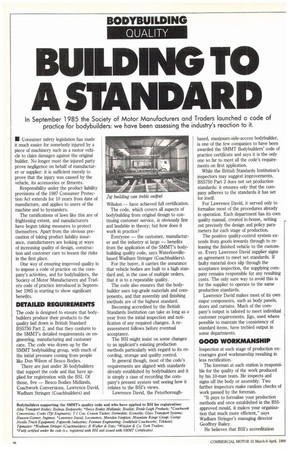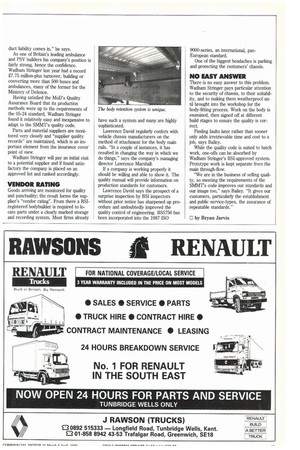BUILDING TO A STANDARD
Page 40

Page 41

If you've noticed an error in this article please click here to report it so we can fix it.
• Consumer safety legislation has made it much easier for somebody injured by a piece of machinery such as a motor vehicle to claim damages against the original builder. No longer must the injured party prove negligence on behalf of manufacturer or supplier: it is sufficient merely to prove that the injury was caused by the vehicle, its accessories or fitments.
Responsibility under the product liability provisions of the 1987 Consumer Protection Act extends for 10 years from date of manufacture, and applies to users of the machine and to bystanders.
The ramifications of laws like this are of frightening extent, and manufacturers have begun taking measures to protect themselves. Apart from the obvious precaution of taking product liability insurance, manufacturers are looking at ways of increasing quality of design, construction and customer care to lessen the risks in the first place.
One way of ensuring improved quality is to impose a code of practice on the company's activities, and for bodybuilders, the Society of Motor Manufacturers and Traders code of practice introduced in September 1985 is starting to show significant benefits.
DETAILED REQUIREMENTS
The code is designed to ensure that bodybuilders produce their products to the quality laid down in British Standard BS5750 Part 2, and that they conform to the SMMT's detailed requirements on engineering, manufacturing and customer care. The code was drawn up by the SMMT bodybuilding group, with much of the initial pressure coming from people like Don Wilson of Besco Bodies.
There are just under 30 bodybuilders that support the code and that have applied for registration with the BSI. Of those, five — Besco Bodies Midlands, Coachwork Conversions, Lawrence David, Wadham Stringer (Coachbuilders) and Wilsdon — have achieved full certification.
The code, which covers all aspects of bodybuilding from original design to continuing customer service, is obviously fine and laudable in theory; but how does it work in practice?
Everyone — the customer, manufacturer and the industry at large — benefits from the application of the SMMT's bodybuilding quality code, says Waterloovillebased Wadham Stringer (Coachbuilders).
For the buyer, it carries the assurance that vehicle bodies are built to a high standard and, in the case of multiple orders, that it is to a repeatable quality.
The code also ensures that the bodybuilder uses top-grade materials and components, and that assembly and finishing methods are of the highest standard.
Becoming accredited by the British Standards Institution can take as long as a year from the initial inspection and notification of any required changes. A reassessment follows before eventual acceptance.
The BSI might insist on some changes to an applicant's existing production methods particularly with regard to its recording, storage and quality control.
In general though, most of the code's requirements are aligned with standards already established by bodybuilders and it is simply a case of recording the company's present system and seeing how it relates to the BSI's views.
Lawrence David, the Peterborough based, maximum-side-access bodybuilder, is one of the few companies to have been awarded the SMMT Bodybuilders' code of practice certificate and says it is the only one so far to meet all the code's requirements on first application.
While the British Standards Institution's inspectors may suggest improvements, BS5750 Part 2 does not set production standards: it ensures only that the company adheres to the standards it has set for itself.
For Lawrence David, it served only to formalise most of the procedures already in operation. Each department has its own quality manual, created in-house, setting out precisely the design and policy parameters for each stage of production.
The positive quality-control system extends from goods inwards through to releasing the finished vehicle to the customer. Every Lawrence David supplier signs an agreement to meet set standards. If faulty material does slip through the acceptance inspection, the supplying company remains responsible for any resulting costs. The only sure way to avoid this is for the supplier to operate to the same production standards.
Lawrence David makes most of its own major components, such as body panels, doors and curtains. Much of the company's output is tailored to meet individual customer requirements. Jigs, used where possible to maintain the consistency of standard items, have trebled output in some departments.
GOOD WORKMANSHIP
Inspection at each stage of production encourages good workmanship resulting in less rectification.
The foreman at each station is responsible for the quality of the work produced by his 10-man team. He inspects and signs off the body or assembly. Two further inspectors make random checks of work passed by the foreman.
"It pays to formalise your production methods and once established in the BSIapproved mould, it makes your organisation that much more efficient," says Wadham Stringer's managing director Geoffrey Bailey.
He believes that BSI's accreditation duct liability comes in," he says.
As one of Britain's leading ambulance and PSV builders his company's position is fairly strong, hence the confidence. Wadham Stringer last year had a record £7.75 million-plus turnover, building or converting more than 500 buses and ambulances, many of the former for the Ministry of Defence.
Having satisfied the MoD's Quality Assurance Board that its production methods were up to the requirements of the 05-24 standard, Wadham Stringer found it relatively easy and inexpensive to adapt to the SMMT's quality code.
Parts and material suppliers are monitored very closely and "supplier quality records" are maintained, which is an important element from the insurance cover point of view.
Wadham Stringer will pay an initial visit to a potential supplier and if found satisfactory the company is placed on an approved list and ranked accordingly.
VENDOR RATING
Goods arriving are monitored for quality and punctuality; the result forms the supplier's "vendor rating". From there a BSIregistered bodybuilder is required to locate parts under a clearly marked storage and recording system. Most firms already have such a system and many are highly sophisticated.
Lawrence David regularly confers with vehicle chassis manufacturers on the method of attachment for the body main rails. "In a couple of instances, it has resulted in changing the way in which we do things," says the company's managing director Lawrence Marshall.
If a company is working properly it should be willing and able to show it. The quality manual will provide information on production standards for customers.
Lawrence David says the prospect of a surprise inspection by BSI inspectors without prior notice has sharpened up procedure and undoubtedly improved the quality control of engineering. BS5750 has been incorporated into the 1987 ISO
NO EASY ANSWER
There is no easy answer to this problem. Wadham Stringer pays particular attention to the security of chassis, to their suitability, and to making them weatherproof until brought into the workshop for the body-fitting process. Work on the body is examined, then signed off at different build stages to ensure the quality is correct.
Finding faults later rather than sooner only adds irretrievable time and cost to a job, says Bailey.
While the quality code is suited to batch work, one-offs can be absorbed by Wadham Stringer's BSI-approved system. Prototype work is kept separate from the main through-flow.
"We are in the business of selling quality, so meeting the requirements of the SMMT's code improves our standards and our image too," says Bailey. "It gives our customers, particularly the establishment and public service-types, the assurance of repeatable standards."
















































































































































